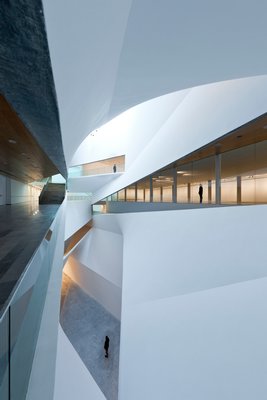
The first talk in a new series at the Parrish Art Museum in Water Mill titled “Inter-Sections: The Architect in Conversation” recently featured a lively, informative and thought-provoking discussion on building for art. The participants, internationally renowned architect Preston Scott Cohen and Parrish director Terrie Sultan—confessing, in full disclosure, that Mr. Cohen is her cousin—explored the evolving nature of a museum as a building typology.The event began with a rather pedagogic recitation by Mr. Cohen on the issues involved in building for art, which include the development of a building program of physical requirements, site analysis, and goals for satisfying a museum’s institutional mission with a vision also appropriate for artists and patrons. He referenced his winning competition entry for the Herta and Paul Amir Building at the Tel Aviv Museum of Art, part of Tel Aviv’s cultural center, to illustrate the ways in which the design process can unfold.
After winning the competition, Mr. Cohen met with Moti Omer, the museum’s director and chief curator. Aspirations for the museum were high and the desired building needed to be “an icon in order for it to be on the international stage.” Confronted with a difficult triangular site and the need for rectilinear galleries, Mr. Cohen needed to solve this inherent conflict, which would dictate the design of the structure. The space requirements necessitated by the program were such that more than 50 percent of the structure had to be built below the existing plaza, as the space for the building was sandwiched in by both a height limitation and the water table.
The solution to the problem came in the form of “Lightfall”, a centrally located, 90-foot-high vertical atrium positioned adjacent to the intersecting galleries of the triangle—all situated in stacked plans. These skewed intersections of overlap, created cascading surfaces between levels and allowed for natural lighting to descend into the very bottom of the atrium.
The form for the outside of the building became a response to the internal configurations. Without going for the cliché of expensive Jerusalem stone, Mr. Cohen played with the geometries to develop a cladding system composed of pre-cast concrete panels attached to a curtain wall made from steel ribs. This solution also allowed for larger, more attractive panels at lower cost.
The one, large subsumed entrance to the museum occurs on a long wall and visitors walk alongside the building in a processional to its entrance. According to Mr. Cohen, this building, with its conventional galleries, also allows for “radical interventions for artists’ exhibitions” since they can produce works on a scale rarely available in most museums. Mr. Cohen added that the architecture “has iconoclastic power to disrupt” as his personal architectural intervention breaks the space open.
When Ms. Sultan and Mr. Cohen sat down together to talk about museums, she mentioned that he had followed the development of the design for the Parrish since its inception. He stated that abstract, tectonic transformations could support significant installations. With the Parrish, he alluded to the influence of the local agrarian buildings, which inspired Herzog and de Meuron‘s design deriving something original from the familiar. Ms. Sultan also mentioned that the interior walls were not structural, and consequently, the building interior has great flexibility and could be opened up at a future date if necessary. Intersections between architects and museum directors, and architects and curatorial staff, can also be in complete opposition. At the Tel Aviv Museum, for example, the staff offices were decentralized while the director remained in the old building.
Ms. Sultan and Mr. Cohen agreed that purpose-built museums may look great as museums, but sometimes the galleries just don’t function, as in Daniel Libeskind’s Denver Museum. Neither thought the new MOMA worked successfully as a museum and was more like a mall for art. Ms. Sultan also quipped that Zaha Hadid’s Cincinnati Museum “was no place to show art.”
A discussion of the museum as spectacle should come as no surprise to the reader. Frank Lloyd Wright’s Guggenheim took a bashing from Mr. Cohen for not working either as a picture gallery or in a social context. Wright designed the Guggenheim to house Non-Objective art and anointed his creation an “archiseum,” which was later described by the critic, Herbert Muschamp, as a “bumptious presence” on Fifth Avenue.
According to Mr. Cohen, “a great building is only great if there’s a great client.” Mr. Omer traveled with Mr. Cohen to look at galleries in many cities. In Renzo Piano’s galleries the light wasn’t right for Mr. Omer and the galleries at Bilbao were a disaster. Mr. Omer, who sadly died before the museum opened, had a vision for a new museum to showcase Israeli art, an understanding of how museums were supposed to work, and what the necessary ingredients were to achieve that end. He also had the respect and trust of the different parties involved in the project.
While Mr. Cohen gave a very thorough description of the external authorities at work in shaping the Tel Aviv Museum, missing in the larger picture of the conversation was any articulation of what drove his own internal authority in generating his vision for the built form. For all of the narratives, the interesting discussion on precedents and architectural genealogy in the building typology it seems peculiar that this museum should be so lacking in symbolic content other than what is self-referential abstraction.
Inter-Sections will continue at the Parrish Art Museum in Water Mill with a screening of “Citizen Jane: Battle for the City” on Sunday, April 30, at 2 p.m.; Architects and Landscape Designers in Conversation on Friday, June 9, at 6 p.m.; and Symposia on Water and Climate Change on Friday, September 22, time to be announced. For more information, visit parrishart.org.